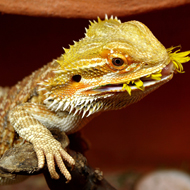Lizards and humans 'share sleep patterns'

Lizard sleep appears to be much simpler, which could mean it is closer to the ancestral mode of brain sleep.
Lizards share sleep patterns with humans, scientists have said, as they described rapid eye movement (REM) sleep and slow wave sleep in a reptile for the first time.
Behavioural sleep is seen in all animals, from humans to insects, but in people, sleep is characterised by periods of slow wave brain activity followed by short phases of REM sleep. These electrical features are not well understood and had previously only been described in humans and birds.
Writing in the journal Science, a research team from the Max Planck Institute for Brain Research in Germany described REM and slow wave sleep in an Australian dragon (Pogona vitticeps).
Lizard sleep patterns were found to share many common features with mammals, including a phase characterised by low frequency/high amplitude average brain activity and rare and bursty neuronal firing (slow wave sleep). Another phase was characterised by awake-like brain activity and rapid eye movements. During slow wave sleep, coordinated activity of cortex with another area was seen. In mammals, that other area is the hippocampus, while in lizards it was the so-called dorsal ventricular ridge.
Some interesting differences were also seen. Lizard sleep rhythms were very regular and fast and the sleep cycle lasted for about 80 seconds, compared to 30 minutes in cats and 60-90 minutes in humans.
In lizards, the duration of REM and slow wave sleep are roughly equal in each cycle, but in mammals, REM is much shorter than slow wave. Both are short and irregular in birds.
On the whole lizard sleep appears to be much simpler, which could mean it is closer to the ancestral mode of brain sleep. Scientists believe it is likely to point towards common origins for mammals, reptiles and birds, rather than a separate, convergent evolution. REM and slow wave sleep may therefore be traced back at least 230 million years to the common ancestor of reptiles, birds and mammals.



 The RCVS has announced a new version of its 1CPD mobile app, with enhanced features for veterinary surgeons and veterinary nurses to record their continuing professional development.
The RCVS has announced a new version of its 1CPD mobile app, with enhanced features for veterinary surgeons and veterinary nurses to record their continuing professional development.